Abstract
Plant derived products have been important source of therapeutic agents, and now days most of the drugs are plant derived products or their derivatives. In many cases, when a plant becomes commercialized as herbal medicine, or when one of its constituents starts getting used as a pharmaceutical drug. Phytochemical group tests were accomplished and presence of alkaloids, steroids and carbohydrates were recognized in the extract. The fenugreek seed is the richest source of soluble and insoluble fiber and also known for its medicinal and functional properties. It contains Multiple chemicals constituents mainly Trigonellin , choline and galactomannan which are responsible for therapeutic activities. The major objective of this present study is fractionation of the fenugreek by Extraction method and characterization of fractions The review of literature study suggests that, plant is found to possess various medicinal activities like Hypoglycaemic, Hypolipidemic, Antihypertensive Antibacterial, and in vitro Antioxidant activity etc.
Keywords
Fenugreek, genotypes, phytochemicals, seeds, trigonella foenum – graecum, antibacterial, antioxidant activity, health benefits.
Introduction
Trigonella foenum-graecum (Fenugreek):-
Fenugreek is important for its use as spices and because of its medicinal applications. Fenugreek plants can be short or tall. While leaves and seeds of short variety of fenugreek are used as food or spices, taller variety is used as medicine. Among various food or garnishing ingredient use of fenugreek following are some of its applications worldwide: stew with rice (in Iran), flavor cheese (in Switzerland), syrup and bitter run (in Germany), mixed seed powder with flour for making flat bread[3] Trigonella foenum-graecum L (fenugreek) has been used as a culinary spice and flavoring agent and as a medicinal plant from ancient times. Fenugreek is a leguminous, herbaceous, rain-fed crop included among the seed spices. It is about 30e60 cm tall. The leaflets are about 2e2.5 cm long and the flowers are 1e2 cm long, axillary, and sessile. It is cultivated throughout the country. Among the spices, fenugreek is used as an esoteric food to enhance the flavor and color of food; it is also used to modify the texture of food. Therapeutic utility indicates fenugreek as a medicinal plant. Medicinal plants are employed in pharmaceuticals, nutraceutical, cosmetics, food supplements, and so on. They are also used as traditional sources of medicine. Among the list of important medicinal plants may be found fenugreek. The seeds and plants are basically hot and dry; they are also suppurative, aperient, and diuretic. They have some useful aspects for dropsy, chronic cough, and enlargement of the liver and spleen. The leaves of fenugreek are beneficial for both internal and external swelling and burns and also applied to prevent the hair from falling out.

Fig. no. 1:- Fenugreek ptant.
Taxonomical Classification:-
Kingdom- Plantae
Super division- Angiosperms
Division- Eudicots
Class- Rosids
Order- Fabales
Family- Fabaceae
Subfamily- Faboideae
Tribe- Trifolieae
Genus- Trigonella
Species- Foenum
Plant part:-
Leaves:-
Leaves are compound and about3-4 cm in lengt. Entire leaflets normally three, lancolate or obovate.
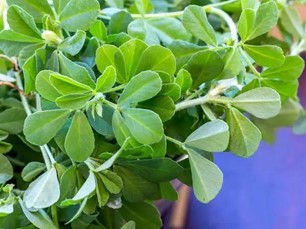
Fig.no.2- Fenugreek leaves.
Flowers:-
Flowers are axillary 1-2 sessile yellow, pods 2-3 cm long, thin, pointed with 10-20 seeds containing a peculiar aroma.
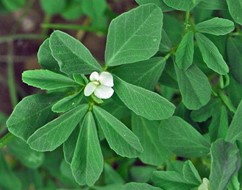
Fig. no.3.- Fenugreek flower.
Seeds:-
Seeds are 4-5 × 2-3 mm in size and having obligue furrow along the length. They are irregularly rhomboidal or square in outline, odourless and yellow in colour or olive green to dark brown.
Taste:-
Taste is bitter and mucilaginous.
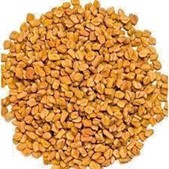
Fig.no.4- Fenugreek seed.
DIABETES MELLITUS:-
Diabetes is a metabolic disorder in which a person has high blood sugar level because either the pancreas does not produce enough insulin or cells do not respond to it. Normally the glucose levels are 80-100 mg/dl (Fasting) and below 140 mg/dl after 2 hours of meals (PPBS), HbA1C- 4%-6%. In Pre-diabetics, Fasting Blood Sugar :110-125 mg/dl, PPBS : 140-160 mg/dl, HbA1c :5.7%-6.4%. In Diabetics, Fasting Sugar : Above 126 mg/dl, PPBS : Above 180 mg/dl;HbA1c : Above 6.5-20. Types of Diabetes mellitus : According to modern concept : Diabetes is of three types21 :
- Type 1 or Insulin Dependent Diabetes Mellitus:
Known as Juvenile diabetes Mellitus. 5-10?ses are diagnosed as Type 1. It is an autoimmune disorder when the immune system goes against its own self causing destruction of the pancreatic cells that produce insulin. Seen usually in children. Increased urination, increased thirst, weight loss are usually seen. No family history generally present. Insulin shots are given usually in modern medicine.
- Type 2 or Non-Insulin Dependent Diabetes Mellitus:
Most common type. Slow onset with symptoms like increased thirst, increased urination and weight loss. Usually these people are obese with sedentary life style and a strong family history. Due to ineffective glucose metabolism, the body uses alternatives like fat metabolism to produce energy leaving the person tired and fatigue seen.
- Gestational Diabetes:
Seen during pregnancy. About 3-5% ladies have chances to develop Gestational diabetes. This happens when the body does not make enough insulin or resist direct action of insulin due to hormones. These patients have 40% chances of developing Type 2 Diabetes if they are obese or have irregular food habits. Diet management alone manages this condition well . Insulin is sometimes given.
Other symptoms22 :
- Polydipsia (Increased thirst) :
The concentration of glucose in blood makes the brain send signals for dilution of blood hence one feel the urge to drink more water
- Polyphagia (Increased appetite) :
Insulin also responsible for hunger, increase insulin level stimulates hunger and desire to eat more
- Polyurea (Increased Urine output) :
Body tries to get rid of increased blood sugar and thus increased urine is seen to eliminate the extra glucose from the body making the sufferer dehydrated and tired.
Earlier seen as weight loss due to utilization of fat from body for energy, later weight gain occurs due to increased appetite.
- Blurred vision
- Irritability
- Infections :
- UTI and Skin infections seen usually Poor wound Healing :
Increased blood glucose inhibits WBC responsible for immunity of the body, delays the healing power. Complications: Untreated Diabetes may lead to irreversible damage to the Eyes (Retinopathy), Kidneys (Nephropathy), Nerves (Neuropathy), Heart (Heart Attack) and Feet (Diabetic Foot).
- Managing Diabetes Mellitus 23:
Both Type 1 and Type 2 Diabetes can be managed through diet, Exercise, Routine check up and Medicines.
A balanced diet with veggies, fruits, whole grain, beans, fish, lean mean meat, non-fat dairy, fiber rich food like salad is suggested.
Frequent and portion meals is the best. It is myth that diabetics have to cut off sugar completely. One can take sugar and curb in permissible limits.
- Management of Diabetes Mellitus through Siddha system of medicine In Siddha system of medicine,
many single and polyherbal formulations and higher medicines like parpam, chendooram and chunnam have been practiced to cure or control diabetes mellitus from time immemorial. In modern medicine no satisfactory effective therapy is still available to cure diabetes mellitus. There is increasing demand by patients to use natural products with anti-diabetic activity due to side effects associated with the use of insulin and oral hypoglycemic agents. Recent overwhelming attention to plant products and alternative medicine has encouraged plant chemists, pharmacologists, biochemists and molecular biologists to combine their efforts in a search for natural agents that can limit diabetes mellitus and its complications.
Herbs and herbal formulation used in Siddha system of medicines for the management of Diabetes mellitus25:-
Single herbs used to manage Diabetes mellitus are:-
- Tinospora cordifolia or Seenthi or Amrit Eugenia jambolena or Nyaval Gymnema sylvestre or Sarkarrai kolli Phyllanthus emblica or Nellikkai or Amla Aegle marmelos or Vilvam or Bael
- Trigonella foenum or Methi or Venthayam Curcuma domestica or Turmeric or Manjal or haldi Andrograhis paniculata or Nilavembu Allium sativum or Garlic
- Siddha polyherbal formulations like Seenthil Kudineer, Seenthi Choornam, Vilva kudineer, Avarai kudineer, Madhumegha choornam, Nyavalkottai Choornam, Silasathu parpam, Abraka chendooram, Triphala Choornam etc are used in treatment of Diabetes
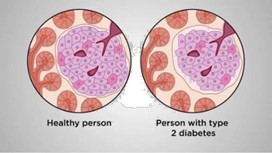
Fig.No.5- Difference Between Normal Pancreas Cell And Diabetec Pancreas Cell.
PATHOGENESIS OF DIABETES: -
A number of factors have been linked to an increased propensity to develop type 2 diabetes. The main risk factors independently associated with diabetes are classified as acquired risk factors and environmental risk factors. The acquired risk factors are age and family history of diabetes and the environmental risk factors are central obesity, body mass index, insulin resistance, physical inactivity, sedentary occupation, urbanization, gestational diabetes and stress. Type 2 diabetes is a dual chronic disorder that, in the majority of patients, arises from defects in both peripheral insulin action (insulin resistance) and insulin secretion ((3-cell dysfunction). The endogenous insulin levels may be normal, depressed or elevated but they are inadequate to overcome the concomitant insulin resistance. As a result hyperglycemia develops. Insulin resistance is first demonstrated in the target tissues, mainly muscle, liver and adipose cells. Initially there is a compensatory increase in insulin secretion which maintains normal glucose concentrations but as the disease progresses insulin production gradually decreases. Hyperglycemia is first exhibited as an elevation of post prandial blood glucose caused by insulin resistance at the cellular level and is followed by an elevation in fasting glucose concentrations. As insulin secretion decreases hepatic glucose production increases causing the increase in pre-prandial blood glucose levels.Epidemiologic data have shown that obesity, sedentary lifestyle and high calorie, high fat diets all correlate with the development of insulin resistance. Physical inactivity along with other risk factors is a significant contributor to global burden of disease.
PHYTOCHEMICALS
The main chemical components of Trigonella foenum-graceum are fiber, flavonoids, polysaccharides, saponins, fixed oils, and some identified alkaloids. Mature seeds mainly contain amino acids, fatty acids, vitamins, saponins, and a large quantity of folic acid (84 mg/100 g). They also contain triethylamine, neurin, trigonelline, choline, gentianine, carpine, betaine, isoleucine, 4-hydroxyisoleucine, histidine, leucine, lysine, L-tryptophan, argenine, gum, neutral detergent, fiber, quercetin, rutin, vitexin, isovitexin, graecunins, fenugrin B, fenugreekine, trigofoenosides A-G, yamogenin, diosgenin, smilagenin, sarsasapogenin, tigogenin, neotigogenin, gitogenin, neotigogenin, yuccagenin, saponaretin, coumarin, lipids, vitamins, 28% mucilage, 22% proteins, and 5% of a strong-smelling, bitter fixed oil.
MATERIALS AND METHODS
Procurement of fenugreek seed :-
Seeds of fenugreek were purchased from local retail market in bilaspur. The seeds were cleaned before drying it in oven at 50 °C for 24 h. Then, the dried seeds were ground using a mill with ultra centrifugal, equipped with ring sieve owning trapezoid holes sized 0.5 mm. The moisture content of the seed was (5.51 – 0.14% d.w basis). The powdered seeds were kept in dark airtight container before extraction.
Analytical reagents and chemicals
Methanol (99% purity), n-hexane (99% purity), 2,2-diphenyl- picrylhydrazyl (DPPH), sodium carbonate, Folin-Ciocateu reagent and gallic acid (GA) were obtained from Sigma Aldrich (M) SdnBhd, Selangore, Malaysia. All chemicals used for the extraction pro-cess were analytical grade with high purity
Extraction process( soxhelation )
A 100 g of crushed fenugreek seed was extracted using nhexane(600 mL) and a Soxhlet extractor for 3 h at (65–700 °C). Then, the mixture of solvent-oil was filtered through a No.1 paper filter (Whatman). The extract was transferred into a round flask and solvent was evaporated using rotary evaporator, (Rotavapor R-200, Büchi, Germany) at 40 °C. Finally, the oil extract was stored at 4 °C to prevent degradation of the compounds for further analysis. The yield of extraction was calculated using Eq. [10]
Extraction yield (v/w %) = amount of oil extracted (ml)/weight of dry sample used (g)x100
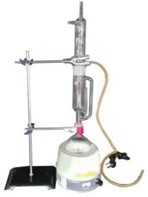
Fig.no.7-soxhletion of fenugreek seed.
Steam distillation:-
Fenugreek seeds (200 g) were soaked in distilled water (1.5 L) at room temperature for 1 h and then boiled while being stirred in a water bath until a slurry was obtained. The solution was cooled and kept in a refrigerator overnight to settle out undissolved materials. The clear solution above the sediment was decanted and centrifuged at 24 × g for 20 minutes. The supernatant was separated and concentrated in a water bath at 60°C to one third of its original volume. The solution was cooled to room temperature and poured into thrice the volume of acetone with continuous stirring. The precipitate was washed repeatedly with acetone and dried at 50-60°C under vacuum. The dried material was powdered and kept in a desiccator.
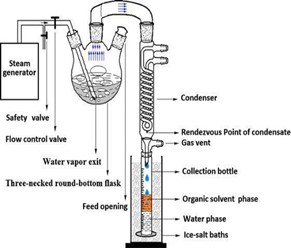
Fig.no.8-Steam distillation of fenugreek seed.
Maceration:-
The fresh seeds of T. foenum-graecum were air-dried and crushed into powder in a grinding machine. The powder (1.5kg) was extracted in Erlenmeyer flasks with 90% ethanol at room temperature

Fig.no.9- Meceration of fenugreek seed.
The maceration was carried out five times each in 48 hrs with occasional shaking and stirring. The whole extract was combined, filtered (Whatman filter paper ) and concentrated at 40°C in vacuo and finally the extract was freeze-dried to get 150gm of crude extract.
Pharmacological Activities/Uses-
Anti-diabetic:-
In animal and human trials, fenugreek seeds were found to lower fasting liquid body substance aldohexose levels. Fenugreek is also used as antidiabetic remedy for I and II polygenic I and II disease. Saponins and diosgenin, two main constituents of fenugreek, are answerable for hypo-lipidemic and anti-diabetic action. Fenugreek is an antihyperglycemic herb in humans and laboratory animals.
Anti-inflammatory activity:-
A 100- and 200-mg/kg dose of fenugreek reduced carrageenan-induced paw swelling in rats. Fenugreek extract contains an alkaloid and it was reported to provide an anti-inflammatory. Property by reducing formalin-induced swelling in rats and an antipyretic property by considerably reducing an physiological state evoked by brewer’s yeast. The anti-inflammatory property of fenugreek may be because of the presence of saponins and flavonoids.
Anti-cancer activity:-
Fenugreek may be a healthful herb to aid cancer patients in therapy interventions. Fenugreek extract has a protective result by modifying cyclophosphamide- induced cell death and free radical-mediated lipid peroxidation within the albino mice model The same result also indicates that fenugreek seed is also important for cancer treatment.
Cardiovascular Disease:-
Endothelial dysfunction is a devastating condition associated with numerous disorders such as hardening of the arteries, hypertension, diabetes mellitus, and so on. Oil obtained from fenugreek, together with different essential oils, was employed to lower pressure in spontaneously hypertensive rats.
Qualitative Test
Macroscopic test:- T.S. of methi exhibits thick cuticle covering epidermal cells. Epidermal cells are polygonal small and thickened. Hypodermic consists of large cells towards periphery and narrow cells towards center. They are circular in shape, thickened and with beaded walls. Parenchyma of teste contains elongated, rectangular cells and beaded walls. Endosperm is irregularly thickened of elongated cells. Endospermic cells contain mucilage. Calcium oxalate crystals, sclereids and starch grains are absent.
Morphology:-
- Appearance:
solid rhomboidal seeds, 3.5 mm long, 2 mm thick. Hard, pebble-like.
- Color:
yellowish brown or light brown.
- Odor:
spicy.
- Taste:
Bitter
Quantitative analysis:-

Table 2: Proximate composition (%) of Fenugreek seeds
RESULTS
Qualitative analysis:-
Ash value
Percentage of ash content – 4.25% w/w
Percentage of acid insoluble ash – 0.42% w/w
Percentage of water soluble ash – 3.82% w/w
Microscopic test:-
Electron microscopic studies of fenugreek seed and the milled fractions The scanning electron microscopy studies of fenugreek seed and milled fractions were carried out using Leo Scanning Electron Microscope (SEM) model 435VP (UK). Samples were placed on a specimen holder with the help of double-sided scotch tape and sputter-coated with gold (2 min, 2 mbar). Finally each sample was transferred to a microscope where it was observed at 15 kV and a vacuum of 9.75×10 ?5 Torr.
Macroscopic test:- .
Appearance:-
solid rhomboidal seeds, 3.5 mm long, 2 mm thick. Hard, pebble-like.
Color:-
yellowish brown or light brown.
Odor:-
spicy.
Taste:-
bitter.
Loss of drying:-
Weight of empty petridish(W1) - 30.94g
Petridish with fenugreek(W2) - 32.94
Petridish with fenugreek after drying(W3) – 32.85
LOD:- W2?W3 × 100
2? 1
= 32.94?32.8432.94?30.94 × 100
= 0.09 × 100
=4.5%
Quantitative Estimation
Phenolic content
The total phenolic content in different solvent extracts (acetone, ethanol and methanol) of the fenugreek seeds , increase in solvent polarity, TP content increased in extract. The Total Phenolic content obtained by acetone 50G.39 mg TE/100 DW was higher significantly (P<0>
Alkaloids
Total concentration of alkaloids in fenugreek seeds 1.8±0.1%
Flavonoid
Flavonoid 12.135±0.465%/ Omami fenugreek seeds ranged for flavonoids 8.46 to 32.81 mg/100g
Tannin
While the tannin 63.69±1.67 mg/100g
Amino acid
Amino acid 70±0.064 mg/100g of fenugreek seeds
CONCLUSION:-
In this minor project, I have mentioned the introduction of herbal medicine and its uses also my projected plant trigolella foenum graceum and mentioned disease diabetes mellitus. Plant introduction and research background such as extraction process, characterization process, phytoconstituents activity and also mentioned reported biological activities present in projected plant trigolella foenum graceum. These plant having a various medicinal and pharmacological application this is already which are already identify such as antimicrobial, anti-inflamatory, antidiabetic, antibiotic and HIV, AIDS, dysentery, diarrhea and lots of pharmacological application of Trigonella foenum-graecum. Trigonella foenum-graecum seeds are also traditionaly used for diabetes mellitus but still there scientifically it should identified properly so this is scientificly validated fort raditional used for diabetes mellitus. Trigonella foenum-graecum having anti bacterial, hypoglycemic action and antidiabetic which are caused by the lower insulin secretion or destruction of -cells of pancreas and my hypothesis is Trigonella foenum-graecum seed extract having property inhibit the glyconeogenesis or to reduce insulin resistance, and my aim of this review is to formulate any other herbal formulation of my projected plant. Expected out come of this project work :- Formulation of anti-diabetic product such as
liquid or solid dosages form to treatment of type-2 diabeties mellitus
REFERENCE:-
- Pengelly, A., & Bone, K. (2020). The constituents of medicinal plants: an introduction to the chemistry and therapeutics of herbal medicine. Routledge.
- Wani, M. S., Parakh, S. R., Dehghan, M. H., Polshettiwar, S. A., Chopade, V. V., & Chepurwar, S. (2007). Herbal medicine and its standardization. Pharmaceutical Reviews, 5(6).
- Das, S. U. B. H. A. S. I. S. H., Dhananjaya, B. L., & Desiraju, S. H. R. I. L. A. K. S. H. M. I.(2018). Trigonella foenum-graceum (fenugreek) for Management of Diabetes. International Journal of Biochemistry Research & Review, 14(3), 1-10.
- Jyothi, D., Koland, M., Priya, S., & James, J. P. (2017). Formulation of herbal capsule containing Trigonella foenum-graecum seed extract for the treatment of diabetes. Journal of Young Pharmacists, 9(3), 352.
- Divya Jyothi*1, Marina Koland2, Sneh Priya2, Jainey Puthenveetil James3
- Das, S. U. B. H. A. S. I. S. H., Dhananjaya, B. L., & Desiraju, S. H. R. I. L. A. K. S. H. M. I. (2018). Trigonella foenum-graceum (fenugreek) for Managemen of Diabetes. International Journal of Biochemistry Research & Review, 14(3), 1-10.
- Chacrabati, R., Afrin, T., Hasan, M. K., & Goswami, C. (2022). Fenugreek (Trigonella foenum-graecum) extract improves hyperglycemia and hyperlipidemia in high sugar diet fed mice. Bangladesh Journal of Animal Science, 51(3), 90-97.
- Rashid, F., Hussain, S., & Ahmed, Z. (2018). Extraction purification and characterization of galactomannan from fenugreek for industrial utilization. Carbohydrate polymers, 180, 88-95.
- Akbari, S., Abdurahman, N. H., Yunus, R. M., Alara, O. R., & Abayomi, O. O. (2019). Extraction, characterization and antioxidant activity of fenugreek (Trigonella-foenum graecum) seed oil. Materials Science for Energy Technologies, 2(2), 349-355.
- Sharghi, A., Badi, H. N., Bolandnazar, S., Mehrafarin, A., & Sarikhani, M. R. (2018). Morphophysiological and phytochemical responses of fenugreek to plant growth promoting rhizobacteria (PGPR) under different soil water levels. Folia Horticulturae, 30(2), 215-228.
- Sur, P., Das, M., Gomes, A., Vedasiromoni, J. R., Sahu, N. P., Banerjee, S., ... & Ganguly, D. K. (2021). Trigonella foenum graecum (fenugreek) seed extract as an antineoplastic agent. Phytotherapy Research: An International Journal Devoted to Pharmacological and Toxicological Evaluation of Natural Product Derivatives, 15(3), 257-259.
- Mowl, A., Alauddin, M., Rahman, M., & Ahmed, K. (2009). Antihyperglycemic effect of Trigonella foenum-graecum (fenugreek) seed extract in alloxan-induced diabetic rats and its use in diabetes mellitus: a brief qualitative phytochemical and acute toxicity test on the extract. African Journal of Traditional, Complementary and Alternative Medicines, 6(3).
- Bahmani, M., Shirzad, H., Mirhosseini, M., Mesripour, A., & Rafieian-Kopaei, M. (2016). A review on ethnobotanical and therapeutic uses of fenugreek (Trigonella foenum-graceum L). Journal of evidence-based complementary & alternative medicine, 21(1), 53-62.
- Sarwar, S., Hanif, M. A., Ayub, M. A., Boakye, Y. D., & Agyare, C. (2020). Fenugreek. In Medicinal Plants of South Asia (pp. 257-271). Elsevier.
- Sarwar, S., Hanif, M. A., Ayub, M. A., Boakye, Y. D., & Agyare, C. (2020). Fenugreek. In Medicinal Plants of South Asia (pp. 257-271). Elsevier.
- Pal, D., Ahuja, C., & Mukherjee, S. (2019). Celsia coromandeliane Vahl-A new biomarker with immense pharmaceutical applications. Journal of Drug Delivery and Therapeutics, 9(3-s), 1109-1115.
- Nathiya, S., Durga, M., & Devasena, T. (2014). Therapeutic role of Trigonella foenum-graecum [fenugreek]–a review. Int. J. Pharm. Sci. Rev. Res, 27(2), 74-80.
- https://www.google.com/search?q=FENUGREEK+EXTRACTION+steam+distillation &tbm=isch&ved=2ahUKEwi73Mri2qH8AhVZynMBHbGzCUMQ2cCegQIABAA&oq=F ENUG REEK+EXTRACTION+steam+
- https://www.google.com/search?q=maceration+extraction&rlz=1C1JJTC_enIN975IN9 75&sxsrf=ALiCzsberQ0naQ3UIokqGMVaUgQtWmrWoA:1672428987882&source=ln ms&tbm=isch&sa=X&ved=2ahUKEwjzh_C9i6L8AhWzTGwGHXoVCfQQ_AUoAXo ECAEQAw&biw=1517&bih=666&dpr=0.9#imgrc=KilXtgHbD2ByJM&imgdii=ynUG sq54RJknJM
- Mulinacci N, Prucher D, Peruzzi M, Romani A, Pinelli P, Giaccherini C, Vincieri FF. Commercial and laboratory extracts from artichoke leaves: estimation of caffeoyl esters and flavonoidic compounds content. Journal of Pharmaceutical and Biomedical Analysis. 2004 Feb 4;34(2):349-57
- Kokate, C.K., Purohit, A.P. and Gokhale, S.B., 2008. Pharmacognosy (Vol. 464). Pune: Niraliprakasha
- Vigh, S., Cziaky, Z., Sinka, L. T., Pribac, C., Mo?, L., Turcu?, V., … & Mathe, E.(2017).
- Vigh, S., Cziaky, Z., Sinka, L. T., Pribac, C., Mo?, L., Turcu?, V., ... & Mathe, E. (2017).Analysis of phytoconstituent profile of fenugreek-Trigonella foenum-graecum L.-seed extracts.
- S., Cziaky, Z., Sinka, L. T., Pribac, C., MO?, L., TURCU?, V., ... & Mathe, E. (2017). Comparative chemomapping of phytoconstituents from different extracts of globe artichoke-Cynara scolymus L. Studia Universitatis Babe?-Bolyai, Chemia, . 62(2, Tom I), 125- 143.
- Sakhare, S. D., Inamdar, A. A., & Prabhasankar, P. (2015). Roller milling process for fractionation of fenugreek seeds (Trigonella foenumgraecum) and characterization of milled fractions. Journal of Food Science and Technology, 52, 2211-2219.
- Uma DB, Ho CW, Wan AWM. Optimization of extraction parameters of total phenolic compounds for Henna (Lawsonia inermis) leaves. Sains Malaysiana. 2010; 39:119-128.
- H. King, R. E. Aubert, and W. H. Herman, “Prevalence, numerical estimates, and projections,” Diabetes Care, vol. 21, p. 1414, 1998.
- A. Eidi, M. Eidi, and M. Sokhteh, “Effect of fenugreek (Trigonella foenum-graecum L) seeds on serum parameters in normal and streptozotocin induced diabetic rats,” Nutr. Res., vol. 27, no. 11, pp.728–733, 2007.
- A. Avalos-Soriano, D. la Cruz-Cordero, J. L. Rosado, and T. Garcia-Gasca, “4-Hydroxyisoleucine from fenugreek (Trigonella foenum-graecum): effects on insulin resistance associated with obesity,” Molecules, vol. 21, no. 11, p. 1596.


 Yogesh Singh Armo *
Yogesh Singh Armo *
 Yogesh kumar Sahu
Yogesh kumar Sahu









 10.5281/zenodo.11115143
10.5281/zenodo.11115143